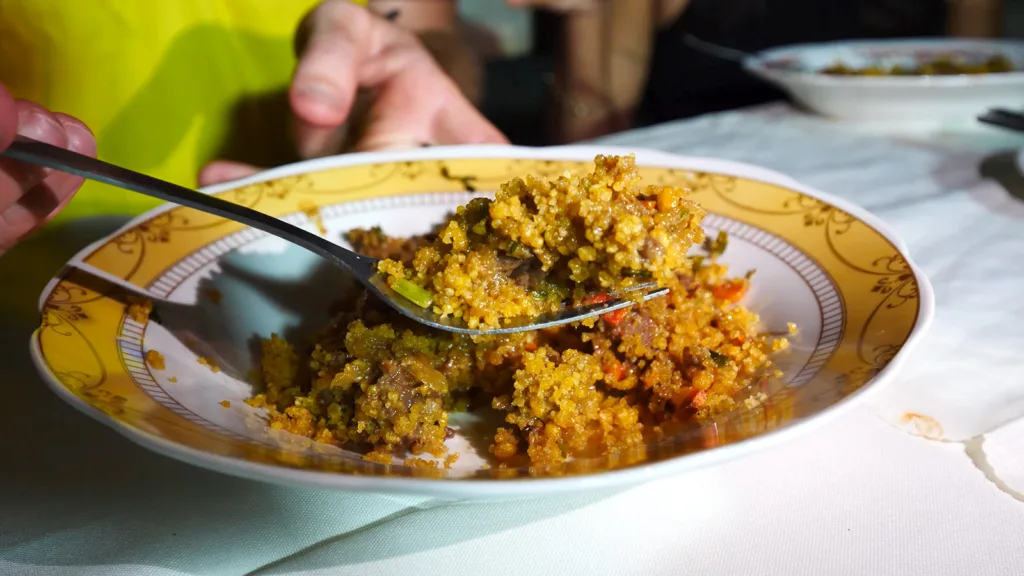My adventures in the Indigenous village of Moraikobai, Guyana continued with some local drinks and some exotic food in the rainforest!
Moraikobai is located roughly four hours southeast of the capital city, Georgetown, and it takes an hour-long car ride and a roughly three-hour speedboat ride to get there!

While I was eager to try some exotic local food, the locals first showed me how to make three alcoholic drinks from the forest: piwari (made from cassava, a root they also use to make bread and sweets), fly (made from purple potatoes), and warup (made from sugarcane). Then, we’d visit the village and have some dinner!
I saw them toasting some cassava bread to make the piwari. After they bake the bread, they tear it up and soak it in water for a day and one night, and add a syrup and some sugar. Then, it ferments and then they strain it! The longer it ferments, the higher the alcohol content.
The piwari was very tasty and refreshing. It had a bit of bitterness but was like a light cassava wine. It was really satisfying!
Next, we saw the purple potatoes that they use to make the drink called fly. The boil the potatoes in water, strain it, and add sugar. I could taste the fermentation! It was fresh and tasted almost like berries!
Then, we headed out into the forest to get some sugarcane for the warup. They have a wooden contraption that extracts the juice from the cane. They press and twist it to make sure they get all the liquid out. I’d never seen a presser like this. I tried my hand at pressing it!
I tried some of the sugarcane, which was nice and sweet. Then, they strained the warup that had been sitting for seven days. It was smooth and tasty!

Then they brought me over to a palm tree trunk they’d cut down. Larvae called Tacoma worms live inside. They chop open the tree to get them out. They look very similar to the larvae I tried in Ghana. They’re eaten as a snack around here, but I was nervous to eat it raw. I didn’t like it, but I was open to trying another one.
The second was tastier. It had a thicker skin, but I could taste the coconut inside it! Then, they gathered more from the trunk, skewered them, and began roasting them over a fire.
The roasted ones were nice and coconutty with a gooey middle, and the skin was easier to eat through. Next, I tried some fried Tacoma worms, which were my favorite ones. They’re still not the best exotic food I’ve ever tried, but they were at least better than the live ones!

After trying the exotic food, we got on a boat and headed to the village. It takes about 10-15 minutes to get there. There’s a gazebo, a guest house, a recreation area where people play volleyball and cricket, and homes.
I was hoping to get some souvenirs there. I found a paddle for roughly $15 USD, similar to one I found in the village of Jaw Jaw in Suriname. While I was there, I met some local women who make some beautiful crafts. After looking over the selection, I bought some earrings for my daughters and the paddle and then headed back to the resort to relax.
Along the way, we crossed a bridge that crosses the river. There was a local guy there doing backflips off the bridge! We had a two-hour break and I took a 90-minute nap before dinner.

My exotic food experience in Moraikobai continued with barbecued chicken, boiled and fried breadfruit, a sun-dried salted beef in gravy dish called tasso, and a couscous-like cassava dish called farine. These dishes are all Rupununi cuisine from the people of the same name.
The farine had a grainy texture like couscous or faro. I loved the combination with the meaty, tender tasso. The gravy was really good! The boiled & fried breadfruit was similar to potatoes but tastier and had a bit of sweetness. And the barbecued chicken was crispy and tender, with a delicious, glaze-like sauce. It was fantastic!
Next was lemongrass tea and roasted corn. The corn was small and contained no butter but was full of flavor. Finally, we finished with cassava bread pudding. It contained vanilla and cherries. It was a great combination!
Counter
101 Countries • 1432 Cities